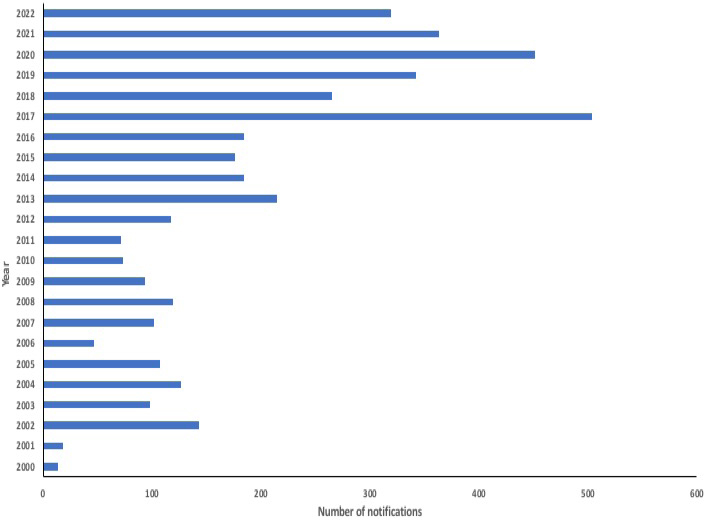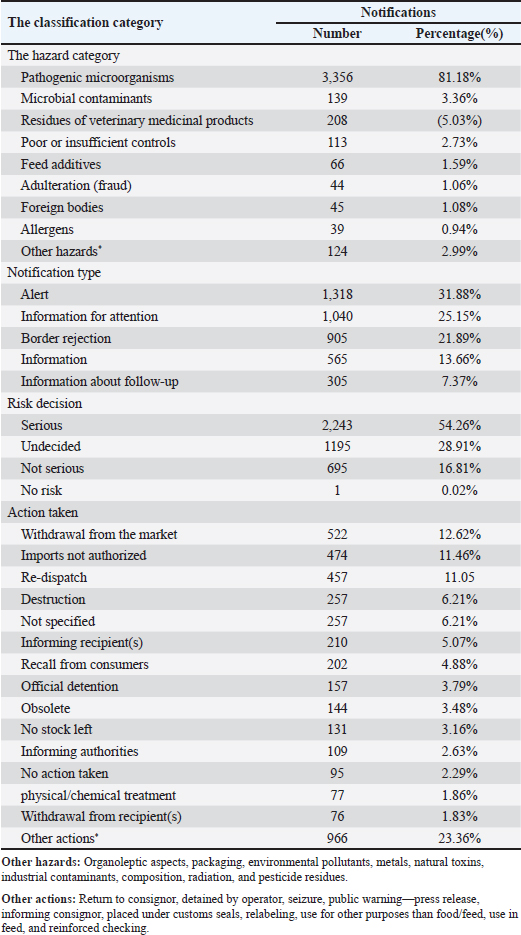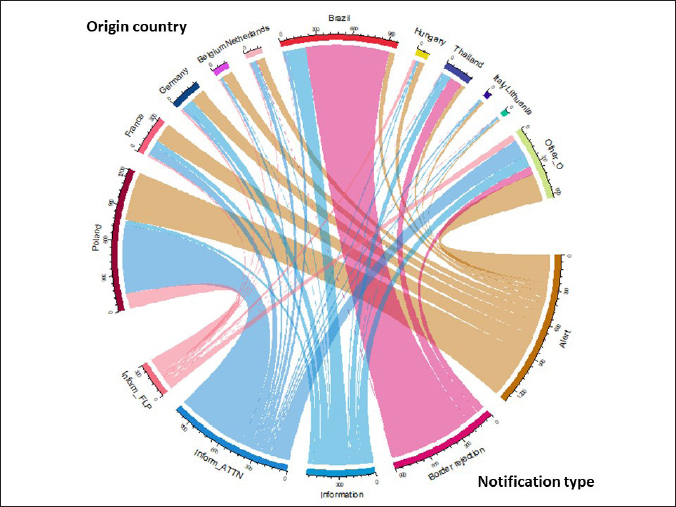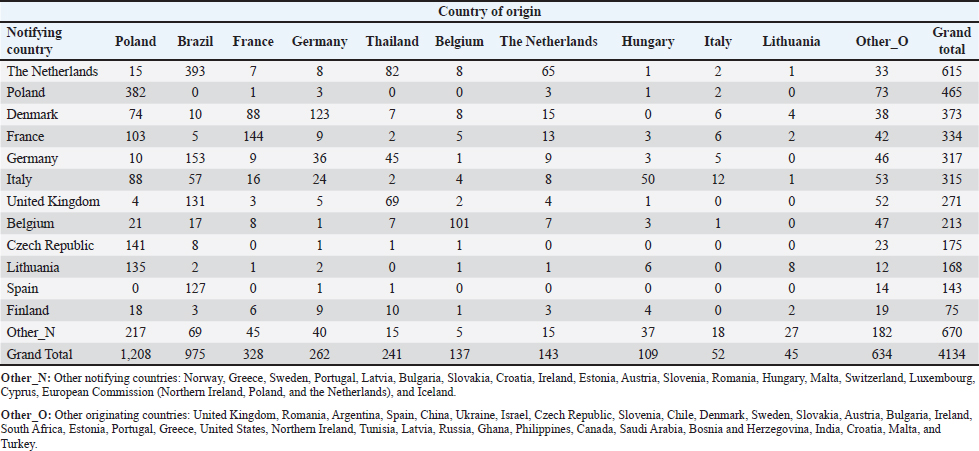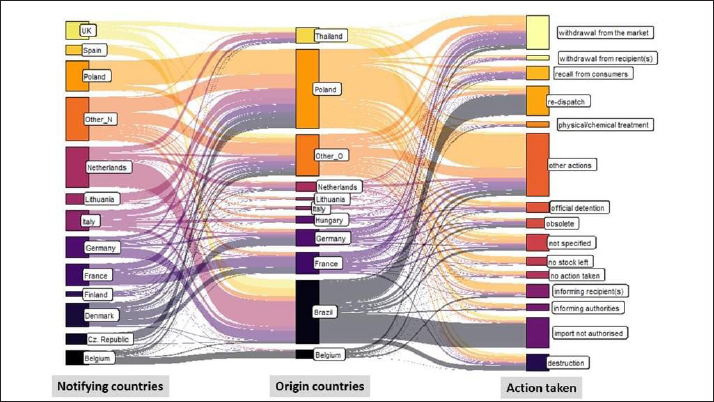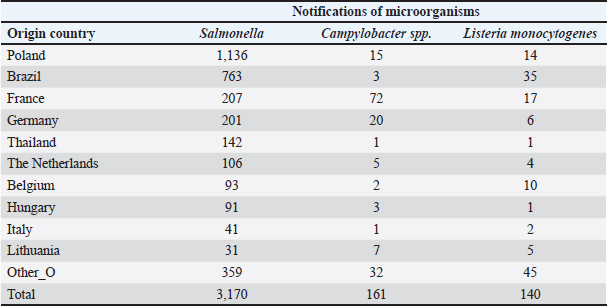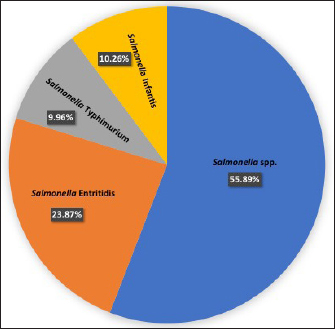
| Research Article | ||
Open Vet. J.. 2025; 15(2): 983-993 Open Veterinary Journal, (2025), Vol. 15(2): 983-993 Research Article Analysis of the hazards associated with poultry meat and its products using European rapid alert system for food and feed notifications from 2000 to 2022Fawzy Eissa1, Ahmed Alfifi2, Alaaeldin Mohamed Saad3, Walaa Fathy SaadEldin4, Heba A. Baz4 and Wageh Sobhy Darwish5*1Environment and Bio-Agriculture Department, Faculty of Agriculture, Al-Azhar University, Cairo, Egypt 2Department of Public Health, College of Veterinary Medicine, King Faisal University, Al-Hofuf, Saudi Arabia 3Department of Zoonoses, Faculty of Veterinary Medicine, Zagazig University, Zagazig, Egypt. 4Educational Veterinary Hospital, Faculty of Veterinary Medicine, Zagazig University, Zagazig, Egypt 5Food Control Department, Faculty of Veterinary Medicine, Zagazig University, Zagazig, Egypt *Corresponding Author: Wageh Sobhy Darwish. Food Control Department, Faculty of Veterinary Medicine, Zagazig University, Zagazig, Egypt. Email: wagehdarwish.com Submitted: 31/12/2024 Accepted: 07/02/2025 Published: 28/02/2025 © 2025 Open Veterinary Journal
AbstractBackground: The European Commission developed the Rapid Alert System for Food and Feeds (RASFF) as a monitoring and reporting tool for food safety risks and consumer protection among the European Union (EU) and the European Economic Area member states. Aim: This study evaluated the notifications of variable hazards on poultry meat and poultry meat products originating from global supply chains to the EU between 2000 and 2022 by analyzing notifications and alert incidences on the RASFF database. Methods: A total of 4,134 notifications were evaluated and analyzed, such studies were reported by 32 countries due to the presence of pathogenic microorganisms, residues of veterinary medicinal products, microbial contaminants, feed additives, and adulteration in addition to poor or insufficient controls from 48 countries worldwide. Results: The highest number of notifications was for poultry meat and poultry meat products imported from Poland (n=1,208; 29.22%) and Brazil (n=975; 23.58%). Among all reported notifications, pathogenic microorganisms were the most predominant (n=3,356; 81.18%) across the variable categories of hazards. Salmonella was the most notified pathogen (n=3,170; 76.68%). According to notification type, alert represented (31.88%), followed by border rejection (21.89%), and based on risk decisions, the vast majority of cases (54.26%) were considered as serious. The main measures taken in response to notifications were withdrawal from the market (12.62%) and import not authorized (11.46%). Conclusion: The results revealed that imported poultry meat and poultry meat products are potential vehicles for clinically relevant risks, including microbial and chemical hazards. Keywords: RASFF, Notifications, Poultry meat products, European Union. IntroductionWorldwide, poultry is the most consumed type of animal protein (OECD-FAO, 2021). According to Fuseini et al. (2023), poultry meat has a low-fat content, is more versatile, is inexpensive, and is easier to cook than other types of meat. In terms of global food imports, the European Union (EU) is ranked second (Jansen et al., 2018). Although international trade increases access to foods derived from animals, other countries worry about food safety breaches and the possibility of zoonotic infections (Attrey, 2017). Numerous elements, such as chemical pollutants and biological dangers, may render food unsuitable for human ingestion (Borchers et al., 2010). The number of incidents of food poisoning has been increasing in recent years worldwide; in fact, experts estimate that 600 million people get sick from food poisoning every year. Every year, over 23 million cases of food poisoning cause 4,500 fatalities and over 400,000 disability-adjusted life years in Europe. The transmission of pathogenic microorganisms such as Salmonella spp., Campylobacter spp., and Listeria monocytogenes can be facilitated by poultry meat and poultry products, according to epidemiological studies (Gonçalves-Tenório et al., 2018; European Food Safety Authority and European Center for Disease Prevention and Control, 2019). The majority of salmonellosis infections, whether sporadic or spillover, originate from poultry (Pires et al., 2011). The European Food Safety Authority identified Salmonella spp. as a pathogen of high concern when inspecting poultry flesh (EFSA, 2012). In addition, according to EFSA (2010), poultry is a common source of Campylobacter spp., which pose a foodborne risk. This is mostly due to cross-contamination with ready-to-eat foods. Approximately 20%–30% of human Campylobacteriosis cases are thought to be caused by broiler meat in some way, shape, or form; however, 50%–80% of these cases may be associated with the entire chicken as a reservoir (EFSA, 2012). According to Gonçalves-Tenório et al. (2018), poultry and other ready-to-eat meals are common sources of listeriosis. There is a need to consider the potential danger to public health posed by chemical pollutants, veterinary product residues, and illegal substances found in food products. Bouzembrak and Marvin (2016) cited food theft as another cause for rejecting EU-delivered food. In addition, between 1998 and 2015, the EU listed the presence of foreign entities in food items as a reason for rejection (Djekic et al., 2017). The EU is a key hub for all its commercial partners throughout the globe. Between 2000 and 2018, there was relatively little change in the percentage of agrifood commerce involving animal products, which accounted for 16% of the overall trade (Chatellier, 2021). This percentage did not include trade within the EU. With 23% of the world’s total exported animal products, the EU is by far the top exporter. The majority of the world’s meat supply comes from chicken and other poultry. In recent years, the United States has been the leading producer, followed by China (16.3%), Brazil (10.9%), and the EU (12.0%), according to data compiled by the Food and Agriculture Organization (FAO) and the Organization for Economic Co-operation and Development (OECD), 2020. In their 2020 forecast, the OECD and the FAO predicted that global poultry meat supplies would rise by 20.3 million tons from 2019 to 2029. According to Chatellier (2021), the top nations in the world that import chicken meat are Japan (16%), the EU (11%), China (10%), Saudi Arabia (5%), and Mexico (5%). The EU is the world’s second largest food importer; therefore, it is crucial that everything that comes into the country meets the stringent quality requirements set by the EU (Jansen et al., 2018). That is why rules and regulations have to be in place for animal products to be imported into the EU from outside the EU. The European Commission developed the Rapid Alert System for Food and Feeds (RASFF) as a notification and monitoring tool. It is an online platform that gathers datasets linked to food safety for EU members. This paves the way for EU and European Economic Area nations to address food safety concerns on a global scale. Warnings, border denials, and information are the three most common forms of RASFF notifications. Notifications can lead to actions such as removal from the market, recall from consumers, and import not authorized dispatch, destruction, adulteration, substitutions, additives, and food fraud (Tahkapaa et al., 2015). RASFF is also used for food safety monitoring. In addition to reducing foodborne illness, RASFF is crucial for identifying the source of foodborne infections and protecting public health (Kowalska and Manning, 2020). Studies by Somorin et al. (2021), Dada et al. (2021), and Lüth et al. (2019) are some of the publications that have focused on food rejections caused by RASFF notifications. This article is the first of its kind to assess the safety of chicken and poultry products imported to the EU from throughout the globe between 2000 and 2022. Materials and MethodsData collection and processingUnder the “Poultry meat and poultry meat products” product category in the RASFF portal database, all notifications were tracked from January 1, 2000, to December 31, 2022, using the product field. We looked at these factors: the date of notification and the type of notification (alert when a product with a serious risk is on the EU market and another country needs to step in quickly); border rejection when a shipment of that product could not enter the EU because it posed a threat to people’s health; or information when a product with a risk but no need for immediate action (either because the risk is not serious or the product was not on the market when the notification was made), the countries that were notified, the categories of hazards, the hazards, the subject, the reason for notification, the risk decisions (not serious, serious, or undecided), and the steps that were taken. The data were exported using descriptive statistical methods, and all data were exported as Excel files. Using IBM SPSS Statistics 20 (SPSS, Chicago, Il) and Microsoft Excel, the data were sorted, filtered, and processed into pivot tables. ResultsNotifications over the yearsA total of 4,134 notifications were reported in the RASFF database for poultry meat and poultry meat products imported by EU countries between 2000 and 2022. The notifications fluctuated between 14 and 184 annually from 2000 to 2016; however, a significant increase appeared in 2017 (n=504), representing the peak of notifications (12.1%) (Fig. 1). Notifications in the last 6 years (2017–2022) accounted for 54% of all notifications. Notification categoriesRASFF notifications can be categorized into four levels (hazard category, notification type, risk decision, and action taken). The hazards category involved in RASFF notifications included different aspects of pathogenic microorganisms (n=3,356; 81.18% as the major cause of notifications, Table 1), followed by residues of veterinary medicinal products (n=208; 5.03%), microbial contaminants (n=139; 3.3%), poor or insufficient controls (n=113; 2.7%), feed additives (n=66; 1.6%), foreign bodies (n=45, 1.08%), and adulteration (n=44, 1.06%). Regarding notification type, most notifications on poultry meat and poultry meat products imported by EU countries were alert notifications (n=1,318; 31.88%), border rejections (n=905; 21.89%), while the other notifications were information (46.2%, Table 1). The categories of types of notifications in relation to country of origin from 2000 to 2022 are shown in Figure 2.
Fig. 1. RASFF notifications for all hazards in poultry meat and poultry meat products imported by European countries from different countries around the world (including EU members) from 2000 to 2022. Based on risk decisions, the most decisions taken was serious (n=2,243, 54.26%), while not serious notifications were considered (n=695; 16.81%). The highest number of notifications was for poultry foods imported from Poland (n=1,208), followed by Brazil (n=975, Table 2). As non-European countries, Brazil and Thailand constituted the countries with the highest number of notifications (n=1216, 29.41%). In total, poultry foods exported by these two countries represented (91.82%) of the border rejection notification type (Table 1). The EU countries of Poland, France, Germany, Belgium, the Netherlands, and Hungary represented the origin of the total notifications (n=2,187; 52.9%). However, very few notifications were reported for poultry foods imported from Canada, Croatia, Saudi Arabia, India, and Malta (Table 2). Notifications were reported by a total of 31 notifying countries in addition to the European Commission. The highest number of notifications was recorded by the Netherlands (n=615; 14.8%), Poland (n=465; 11.2%), and Denmark (n =373; 9%) (Table. 2), while the least notifications were reported by Slovenia, Romania, Hungary, Greece, Portugal, Malta, Switzerland, Luxembourg, Cyprus, European Commission, Iceland, and European services (a total of only 169 notifications were reported by previously mentioned countries over the two decades of the study). Regarding the actions taken, the majority of reported poultry foods were withdrawn from the market (n=522; 12.62%), import was not authorized (474; 11.46%), or re-dispatched to the originating country (n=457; 11.05%) (Table 1). The most common actions related to notifications from Brazil and Thailand were imports that were not authorized and re-dispatched (Fig. 3). However, withdrawal from the market was the most taken action in response to RASFF notifications originating from EU countries such as Poland, France, Germany, and Belgium (Table 3). Table 1. RASFF notifications of variable hazards in poultry meat and poultry meat products (n=4,134) originating from different countries around the world (including EU members) from 2000 to 2022 based on notification category
Fig. 2. Types of RASFF notifications (n=4,134) originating from different countries worldwide (including EU members) by country of origin from 2000 to 2022. Inform_ATTN=Information for attention, Inform_FLP=Information for followup. Other_O=Other originating countries, i.e., United Kingdom, Romania, Argentina, Spain, China, Ukraine, Israel, Czech Republic, Slovenia, Chile, Denmark, Sweden, Slovakia, Austria, Bulgaria, Ireland, South Africa, Estonia, Portugal, Greece, United States, Northern Ireland, Tunisia, Latvia, Russia, Ghana, Philippines, Canada, Saudi Arabia, Bosnia and Herzegovina, India, Croatia, Malta, and Turkey. The length of the arc on the circumference of the circle represents the number of notifications for each food category. Hazard categories involved in RASFF notificationsRASFF notifications related to poultry meat and poultry products within the last two decades were mainly due to pathogenic microorganisms (81.18%). Among the 3,356 notifications of pathogenic microorganisms from 2000 to 2022, Salmonella was the most predominant pathogen, accounting for 3,170 (94.45%) of notified pathogenic microorganisms and 76.68% of total RASFF notifications (Table 3). The Campylobacter species and L. monocytogenes represented 161 (3.89%) and 140 (3.38%) of the total notifications, respectively. The total number of notifications related to Salmonella was 3,170, whereas a higher total number of pathogens (n=3,342) was identified because of the co-occurrence of Salmonella in poultry meat and poultry meat products. Among the implicated species or serovars in Salmonella notifications, the most frequently identified serovars were Enteritidis 798 (23.87%), followed by Infantis 343 (10.26%) and Typhimurium 333 (9.96%), whereas other Salmonella pathogens 1868 (55.89%) were not further characterized as serovars (Fig. 4). Poland had the highest number of notifications of Salmonella (1,136, 35.83%) overall origin countries (Table 3), followed by Brazil (763, 24.06%). On the whole, poultry meat and poultry meat products imported from Poland, Brazil, France, Germany, Thailand, and the Netherlands represented more than 80% (i.e. 2,555/3,170) of the Salmonella notifications (Table 3). In addition to Salmonella, Campylobacter was the next most common pathogen, and it was reported at a much lower frequency than that of Salmonella (161, 3.89%). Poultry foods originating from France were responsible for 44.72% (i.e. 72/161) of all Campylobacter notifications within the last two decades (Table 3). Listeria monocytogenes was detected at a similar frequency as Campylobacter (140, 3.38%). However, in nonsignificant numbers, Brazil, followed by France, was the origin for most L. monocytogenes notifications at 35 and 17, respectively (Table 3). Table 2. RASFF notifications of variable hazards in poultry meat and poultry meat products (n=4,134) originating from different countries around the world (including EU members) from 2000 to 2022 based on the notifying country.
Fig. 3. Sankey diagram of notifying country versus originating country and action taken. Table 3. RASFF notifications based on pathogenic microorganisms and microbial contaminants in relation to origin countries.
However, the notifications due to residues of veterinary medicinal products were 208 (5.03%) of the total notifications, representing the highest number of recorded hazards following the number of pathogenic microorganism notifications (Table 4). The highest number of notifications due to residues of veterinary medicinal products was for poultry meat and poultry meat products originating from Brazil (1.83%) and Thailand (1.66%). The least commonly notified hazards were use-by-date exceeding, Shiga toxin-producing E. coli, and mold infestation (Table 4). DiscussionPoultry meat is the first type of meat produced and consumed in the world (Chatellier, 2021). The presence of pathogenic microorganisms, microbial contaminants, and chemical residues in food products, particularly poultry meat foods, represents a high risk to public health. In this study, we investigated the notifications related to microbial and chemical hazards in poultry foods imported by the EU between 2000 and 2022. The notifications of poultry imports to EU countries increased from (14 ~ 184) notifications annually between 2000 and 2016 to 504 in 2017 and 319 in 2022. This growing notification trend could be due to increased production and world trade of poultry foods over the years (OECD-FAO, 2020) and also could be related to climate change, especially for microbial notifications (Milazzo et al., 2016; Maggiore et al., 2020).
Fig. 4. Species of Salmonella identified in 3,170 RASFF notifications in poultry meat and poultry meat products originating from different countries around the world (including EU members) from 2000 to 2022. N.B. The total number of Salmonella (n=3,342) exceeded the total number of notifications (n=3,170) because of the co-occurrence of different Salmonella serovars. Of the 4,134 notifications, most were for poultry meat products originating from Poland (n=1,248), Brazil (n=997), France (n=339), Germany (n=280), and Thailand (n=242). The volume of trade concerning poultry products between these countries and the EU could be a major contributor to such notifications (European Commission, 2023a). In 2022 and 2023, Poland was the main poultry producer country in the EU (21% of total European poultry production), while France and Germany represented 11% of total poultry production in the EU (USDA, 2022) and (European Commission, 2023). Brazil is the main exporter of poultry products worldwide with 330–390 thousand tons in 2022–2023, while Thailand is the fourth exporter in the world, with around 50,000 tonnes in the same period (European Commission, 2023b). In 2018, a large proportion of European poultry imports were 30% from Brazil and 47% from Thailand (Chatellier, 2021). A more likely explanation for such notifications is the nature of the microbial and chemical hazards in the implicated poultry foods. The highest number of notifications reported by EU countries was in 2017. Pathogenic microorganisms, mainly Salmonella, increased among the most frequently reported pathogens in poultry meat products among member countries, as 1,136 notifications from Poland and also among non-member countries as Brazil caused 763 notifications of Salmonella in poultry meat mostly notified by the Netherlands, Germany, and the United Kingdom in addition to 142 notifications resulting from chicken meat from Thailand, which is compatible with previous reports (European Commission, 2017). Moreover, Campylobacter species and L. monocytogenes were shared among the microbial notifications by a minor percentage. In the same manner, residues of veterinary medicinal products, microbial contaminants, poor or insufficient controls, and feed additives represented a minor percentage of all notifications (11.1%). Risk management strategies are highly required to minimize pathogenic incidence in poultry meat, particularly for Salmonella spp., Campylobacter spp., and L. monocytogenes throughout the entire food chains among EU members (EFSA, 2012; Gonçalves-Tenório et al., 2018; Khalid et al., 2020). Proper hygiene and safety practices have been suggested as the main intervention for imported poultry meat products to comply with EU national market requirements (Jansen et al., 2018; Khalid et al., 2020). The highest number of notifications was reported by the Netherlands (14.88%). This is easily recognized because of the implementation of high standards for food quality and safety measurements in the Netherlands (Verbruggen and Havinga, 2015). Notifications made by the Netherlands mainly concerned poultry meat products originating from Brazil and Thailand. Food safety in Brazil has been a major challenge with huge impacts on public health due to inappropriate hygienic conditions and fewer establishments and policies to monitor and ensure the adequacy of food services (Lucca and Torres, 2006; Campos et al., 2009; Saccol et al., 2013; Cunha et al., 2014; Almeida Júnior et al., 2017). In Thailand, food safety programs, establishments, and guidelines need to be strengthened by the Thai government to reduce the huge impact of food safety defiance on public health, international trade, and economics (Takeuchi and Boonprab, 2006; Chaoniruthisai et al., 2018; World Health Organization, 2020). The highest number of notifications was for poultry meat and poultry meat products originating in Poland. This could be due to the leading poultry industry in Poland among EU countries (European Commission, 2023b). In contrast, Poland was the second country to report notifications related to poultry hazards. This could be due to the implementation of requirements for safety assurance in food production and hygiene in Poland (Trafiałek and Kołożyn-Krajewska, 2011). Table 4. RASFF notifications of variable hazards in poultry meat and poultry meat products (n=4,134) originating from different countries around the world (including EU members) from 2000 to 2022 based on the originating country.
Data obtained through the RASFF represent an important source of information for monitoring emerging health risks related to specific food products. Border rejections were the most common type of notification following alert notifications in this study, while the most commonly taken actions were product withdrawal from the market, non-authorization of imports, and product re-dispatch to the originating country. These actions are considered stringent responses by the EU to safeguard public health (Almeida Júnior et al., 2017; Chaoniruthisai et al., 2018). ConclusionFrom 2000 to 2022, the EU imported poultry and other poultry products from worldwide supply chains. The countries with the highest number of notifications were Poland and Brazil, and these were mostly caused by harmful microorganisms. Salmonella is the most frequently reported foodborne pathogen in poultry products imported to the EU. More than 59% of these notifications were from Poland and Brazil. Poultry food hazards are not a “one country” problem; they are linked to consumers through food supply systems that span international borders. Critically important is RASFF’s role as a European monitoring system and its prompt response to food safety concerns. Additionally, the large-scale detection and transmission of possible concerns to EU consumers make a significant contribution to risk assessment. To protect public health and maintain the economic prosperity of nations that produce food, it is necessary to understand the problems related to food safety in international supply chains. This includes implementing good manufacturing practices and food management systems. Along with the RASFF warnings, extra meta-data for risk factor identification should be made available so that the problem can be addressed at its source. Conflict of interestThe authors declared no relevant financial or nonfinancial interests. FundingThe authors declare that no funds, grants, or other support were received during the preparation of this manuscript. Consent to participateAll authors have accepted to participate in this study. Consent to publish the revised manuscriptAll authors have accepted the publication of this manuscript. Ethical approvalNo animal or human subjects were used in this study. Author contributionsAll authors contributed equally to the study. ReferencesAlmeida Júnior, W.L.G.D., Souza, J.V.D., Freire, N.B., Miranda, F.B., Carrijo, K.D.F. and Dias, F.S. 2017. Verification of good practices in food establishments in Petrolina, semi-arid region of Pernambuco, Brazil. Biosci. J. 2017, 996–1006. Attrey, D.P. 2017. Food safety in international food trade—imports and exports. In Food safety in the 21st century, 2017. Eds., Gupta, R.K., Dudeja, P. and Singh, M. San Diego, CA: Academic Press, pp: 455–468; doi:10.1016/B978-0-12-801773-9.00037-6 Borchers, A., Teuber, S.S., Keen, C.L. and Gershwin, M.E., 2010. Food safety. Clin. Rev. Allerg. Immunol. 39, 95–141. Bouzembrak, Y. and Marvin, H.J. 2016. Prediction of food fraud type using data from rapid alert system for food and feed (RASFF) and Bayesian network modelling. Food Control. 61, 180–187. Campos, A.K.C., Cardonha, Â.M.S., Pinheiro, L.B.G., Ferreira, N.R., de Azevedo, P.R.M. and Stamford, T.L.M. 2009. Assessment of personal hygiene and practices of food handlers in municipal public schools of Natal, Brazil. Food Control. 20(9), 807–810. Chaoniruthisai, P., Punnakitikashem, P. and Rajchamaha, K. 2018. Challenges and difficulties in the implementation of a food safety management system in Thailand: a survey of Brc certified food productions. Food Control. 93, 274–282. Chatellier, V. 2021. Review: international trade in animal products and the place of the European Union: main trends over the last 20 years. Animal 15 100289. Cunha, D.T., Stedefeldt, E. and Rosso, V.V. 2014. The role of theoretical food safety training on Brazilian food handlers’ knowledge, attitude and practice. Food Control. 43, 167–174. Dada, A.C., Somorin, Y.M., Ateba, C.N., Onyeaka, H., Anyogu, A., Kasan, N.A. and Odeyemi, O.A. 2021. Microbiological hazards associated with food products imported from the Asia-Pacific region based on analysis of the rapid alert system for food and feed (RASFF) notifications. Food Control. 129, 108243. Djekic, I., Jankovic, D. and Rajkovic, A. 2017. Analysis of foreign bodies present in European food using data from rapid alert system for food and feed (RASFF). Food Control. 79, 143–149. EFSA. 2010. Scientific opinion on quantification of the risk posed by broiler meat to human campylobacteriosis in the EU. EFSA J. 8, 1437. EFSA. 2012. EFSA panel on contaminants in the food chain (CONTAM); EFSA panel on animal health and welfare (AHAW). Scientific opinion on the public health hazards to be covered by inspection of meat (Poultry). EFSA J. 10, 2741. European Commission. 2017. RASFF—the rapid alert system for food and feed—2017 annual report. Luxembourg City, Luxembourg: European Commission. European Commission. 2023a. Information on an overview of EU poultry, market measures and standards, trade measures, market monitoring, legal bases and committees. Luxembourg City, Luxembourg: European Commission. Available via Https://Agriculture. Ec. Europa. Eu/Farming/Animal-Products/Poultry_En European Food Safety Authority and European Centre for Disease Prevention and Control. 2019. The European Union one health 2018: zoonoses report. EFSA J. 17, 1–276; doi: 10.2903/j.efsa.2019.5926 Fuseini, A., Miele, M. and Lever, J. 2023. Poultry welfare at slaughter. Poultry 2, 98–110. Gonçalves-Tenório, A., Silva, B.N., Rodrigues, V., Cadavez, V. and Gonzales-Barron, U. 2018. Prevalence of pathogens in poultry meat: a meta-analysis of European published surveys. Foods 7, 69. Jansen, W., Woudstra, S., Müller, A., Grabowski, N., Schoo, G., Gerulat, B., Klein, G. and Kehrenberg, C. 2018. The safety and quality of pork and poultry meat imports for the common European market received at border inspection post Hamburg Harbour between 2014 and 2015. PLoS One 13(2), e0192550. Khalid, T., Hdaifeh, A., Federighi, M., Cummins, E., Boué, G., Guillou, S. and Tesson, V. 2020. Review of quantitative microbial risk assessment in poultry meat: the central position of consumer behavior. Foods 9, 1661. Kowalska, A. and Manning, L. 2020. Using the rapid alert system for food and feed: potential bene Ts and problems on data interpretation. Crit. Rev. Food Sci. Nut. 61, 1–14. Lucca, A. and Torres, E.A.F.S. 2006. Street-food: The hygiene conditions of Hot-Dogs sold in São Paulo, Brazil. Food Control. 17(4), 312–316. LüTh, S., Boone, I., Kleta, S. and Al Dahouk, S. 2019. Analysis of RASFF notifications on food products contaminated with Listeria monocytogenes reveals options for improvement in the rapid alert system for food and feed. Food Control. 96, 479–487. Maggiore, A., Afonso, A., Barrucci, F. and De Sanctis, G. 2020. Climate change as a driver of emerging risks for food and feed safety, plant, animal health and nutritional quality. EFSA J. 17(6), p. 1881E. Milazzo, A., Milazzo, A., Giles, L.C., Zhang, Y., Koehler, A.P., Hiller, J.E. and Bi, P. 2016. The effect of temperature on different Salmonella serotypes during warm seasons in a Mediterranean climate city, Adelaide, Australia. Epidemiol. Infect. 144, 1231–1240. OECD-FAO. 2020. OECD and FAO agricultural outlook 2020-2029. Paris, France: OECD Publishing. OECD-FAO. 2021. Agricultural outlook 2021–2030. Paris, France: OECD Publishing. Pires, S., De Knegt, L. and Hald, T. 2011. Estimation of the relative contribution of different food and animal sources to human Salmonella infections in the European Union. EFSA J. 8(8): 184E. doi: 10.2903/sp.efsa.2011.EN-184 Saccol, A.L., Serafim, A.L., Hecktheuer, L.H., Medeiros, L.B., Spinelli, M.G., de Abreu, E.S. and Chaud, D.M. 2013. Hygiene and sanitary conditions in self-service restaurants in São Paulo, Brazil. Food Control. 33, 301–305. Somorin, Y.M., Odeyemi, O.A. and Ateba, C.N. 2021. Salmonella is the most common foodborne pathogen in African food exports to the European Union: analysis of the rapid alert system for food and feed (1999–2019). Food Control. 123, 107849. Tahkapaa. S., Maijala, R., Korkeala, H. and Nevas, M. 2015. Patterns of food frauds and adulterations reported in the EU rapid alert system for food and feed in Finland. Food Control. 47, 175–184. Takeuchi, M.T. and Boonprab, K. 2006. Food safety situations in Thailand with regard to their Thai’s food safety knowledge an behaviors. Kasetsart. J. Nat. Sci. 40, 222–228. Trafiałek. J. and Kołożyn-Krajewska, D. 2011. Implementation of safety assurance system in food production in Poland. Pol. J. Food Nutr. Sci. 61(2), 115–124. USDA. 2022. Poultry and products annual. Report Number: E42022-0065. Available via Https://Apps.Fas.Usda.Gov/Newgainapi/Api/Report/Downloadreportbyfilename?Filename=Poultry%20and%20Products%20Annual_Paris_European%20Union_E42022-0065.Pdf Verbruggen, P. and Havinga, T. 2015. Food safety meta-controls in the Netherlands. Eur. J. Risk Reg. 6, 512–524. World Health Organization. 2020. Food safety. Geneva, Switzerland: World Health Organization. Available via Https://Www. Who. Int/NEws-Room/Fact-Sheets/Detail/Food-Safety | ||
| How to Cite this Article |
| Pubmed Style Eissa F, Alfifi A, Saad AM, Saadeldin WF, Baz HA, Darwish WS. Analysis of the hazards associated with poultry meat and its products using European rapid alert system for food and feed notifications from 2000 to 2022. Open Vet. J.. 2025; 15(2): 983-993. doi:10.5455/OVJ.2025.v15.i2.47 Web Style Eissa F, Alfifi A, Saad AM, Saadeldin WF, Baz HA, Darwish WS. Analysis of the hazards associated with poultry meat and its products using European rapid alert system for food and feed notifications from 2000 to 2022. https://www.openveterinaryjournal.com/?mno=240613 [Access: December 02, 2025]. doi:10.5455/OVJ.2025.v15.i2.47 AMA (American Medical Association) Style Eissa F, Alfifi A, Saad AM, Saadeldin WF, Baz HA, Darwish WS. Analysis of the hazards associated with poultry meat and its products using European rapid alert system for food and feed notifications from 2000 to 2022. Open Vet. J.. 2025; 15(2): 983-993. doi:10.5455/OVJ.2025.v15.i2.47 Vancouver/ICMJE Style Eissa F, Alfifi A, Saad AM, Saadeldin WF, Baz HA, Darwish WS. Analysis of the hazards associated with poultry meat and its products using European rapid alert system for food and feed notifications from 2000 to 2022. Open Vet. J.. (2025), [cited December 02, 2025]; 15(2): 983-993. doi:10.5455/OVJ.2025.v15.i2.47 Harvard Style Eissa, F., Alfifi, . A., Saad, . A. M., Saadeldin, . W. F., Baz, . H. A. & Darwish, . W. S. (2025) Analysis of the hazards associated with poultry meat and its products using European rapid alert system for food and feed notifications from 2000 to 2022. Open Vet. J., 15 (2), 983-993. doi:10.5455/OVJ.2025.v15.i2.47 Turabian Style Eissa, Fawzy, Ahmed Alfifi, Alaaeldin Mohamed Saad, Walaa Fathy Saadeldin, Heba A. Baz, and Wageh Sobhy Darwish. 2025. Analysis of the hazards associated with poultry meat and its products using European rapid alert system for food and feed notifications from 2000 to 2022. Open Veterinary Journal, 15 (2), 983-993. doi:10.5455/OVJ.2025.v15.i2.47 Chicago Style Eissa, Fawzy, Ahmed Alfifi, Alaaeldin Mohamed Saad, Walaa Fathy Saadeldin, Heba A. Baz, and Wageh Sobhy Darwish. "Analysis of the hazards associated with poultry meat and its products using European rapid alert system for food and feed notifications from 2000 to 2022." Open Veterinary Journal 15 (2025), 983-993. doi:10.5455/OVJ.2025.v15.i2.47 MLA (The Modern Language Association) Style Eissa, Fawzy, Ahmed Alfifi, Alaaeldin Mohamed Saad, Walaa Fathy Saadeldin, Heba A. Baz, and Wageh Sobhy Darwish. "Analysis of the hazards associated with poultry meat and its products using European rapid alert system for food and feed notifications from 2000 to 2022." Open Veterinary Journal 15.2 (2025), 983-993. Print. doi:10.5455/OVJ.2025.v15.i2.47 APA (American Psychological Association) Style Eissa, F., Alfifi, . A., Saad, . A. M., Saadeldin, . W. F., Baz, . H. A. & Darwish, . W. S. (2025) Analysis of the hazards associated with poultry meat and its products using European rapid alert system for food and feed notifications from 2000 to 2022. Open Veterinary Journal, 15 (2), 983-993. doi:10.5455/OVJ.2025.v15.i2.47 |





